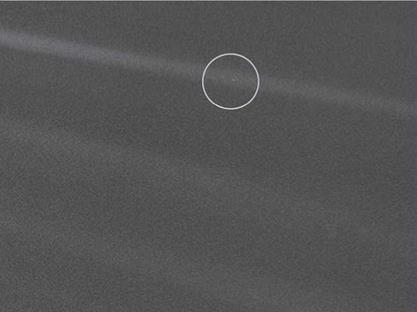The Pale Blue Dot
Of the stunning images Voyager sent back, perhaps none have more profoundly shaped our understanding of humankind’s place in space than Voyager 1’s photo of Earth from the icy reaches of the outer Solar System. The “Pale Blue Dot” image represents one of the most significant of the mission and of our time. In February 1990, while 3.7 billion miles from Earth, Voyager 1 snapped sixty photographs looking toward the Sun, and over the next three months transmitted the images to Earth. Among the last six frames of the photo shoot, only one included humankind’s most distant view of Earth. When Sagan suggested that Voyager’s imaging team attempt the photographs, NASA administrators apparently were reluctant to authorize it, as programming the commands to take additional images was labor intensive and it was not clear whether the data would be scientifically useful. Candice Hansen, who helped design Voyager’s imaging observations, and several others joined Sagan in arguing for the photographs. Hansen recalls how intently the imaging science team wanted to obtain what was later called the Family Portrait: “We were really after the picture of the Earth, so we had to look for the point in the Earth’s orbit which would have it as far away as possible from the Sun. It turned out that we could also get Neptune, Uranus, Saturn, Jupiter, and Venus.” Hansen, like Sagan, realized that an image of Earth viewed from billions of miles away would intrinsically “strike a chord. . . that might affect people’s view of the world.”30 They couldn’t have been more prescient.
By sheer chance, the Earth appears in the photo as though caught in the band of a rainbow. This artifact in the image is caused by sunlight reflecting off the spacecraft (figure 4.3). Sagan noted that it only accentuated how diminutive our world is in the empty wastes of outer space. Jurrie Van Der Woude, public infor-
|
Figure 4.3. The Pale Blue Dot is an image taken of the Earth by the Voyager 1 spacecraft in 1990 at a distance of 3.7 billion miles. Carl Sagan requested that the camera be pointed back toward Earth, seen projected behind a ray of scattered light from the Sun. The image became one of the most iconic in the history of the space program (NASA/JPL-Caltech). |
mation officer for the mission, explained the difficulties in actually acquiring Voyager’s final six photographs, including the singular image of Earth that so powerfully and visually characterized our minute place in space:
They were stored onboard Voyager on the tape recorder, for the simple reason that the Deep Space Network—those big antennas in Australia, Madrid, and Goldstone, California—were too busy with Magellan and Galileo to listen to poor old Voyager. At the end of March, we played that sequence of photographs back, and the last series of photographs, five or six, were being received by the Madrid antenna when it rained. That blocked out the data, so in April we had to give it another shot. This time the antenna in use was the one at Goldstone, which turned out to have a hardware problem. As a result we still did not get those six photographs, so we had to do it again in May, when we finally got them.31
Wyn Wachhorst writes, “To stand on the moons of Saturn and see the Earth in perspective is to act out the unique identity of our species.”32 Wachhorst quite accurately points out that viewing Earth from the outer planets had radically altered our collective human consciousness. The Apollo missions afforded us the first opportunity to see the Earth from 240 million miles away. Apollo 8’s photo of the gibbous Earth emerging from the limb of our desiccated and cratered Moon, Earthrise, along with Apollo 17’s Whole Earth photo are among the defining images of the manned lunar program and of the twentieth century. Apollo 8 astronaut James Lovell, commenting on the view of Earth as the astronauts orbited the Moon in December 1968, noted: “The [E]arth from here is a grand oasis in the big vastness of space.”33 Voyager, conversely, had captured a chance glimpse of the dot of Earth forging into the empty abyss on its course around the Sun. In 4.5 billion years, our Solar System has never traversed the same wastes of space—nor will it ever. It is a staggering reorientation made visceral through the photo of the pale blue dot. With that single image, Voyager brought into focus the fractional blue world on which our lives, our narratives, and our art have mattered.











